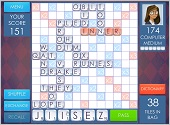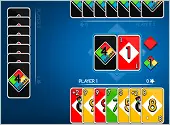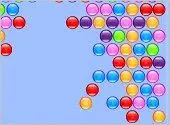- Home
- Better Memory
- Brain Games
- Sudoku Printables
- Sudoku Instructions
Sudoku Instructions: How to Play and Win
by Kevin Rush (guest author)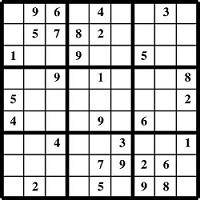
The free Sudoku instructions below, written by Sudoku guru Kevin Rush, will teach you how to solve Easy, Medium, and Hard Sudoku puzzles. You will learn basic strategy plus Sudoku tricks such as Ghosting, RC Counting, Tagging, and Line Checking.
To get much better at Sudoku, study the explanations in this guide carefully. Take your time to understand the examples. Whether you are a beginner at Sudoku or an experienced player, the skills you need to solve these puzzles are described right here.
These tricks and strategies are the methods used by Kevin Rush, an expert-level player. As an example of his skill, Kevin is able to solve "insane" (6-star difficulty) Sudoku puzzles in 8-10 minutes. Thank you for sharing these wonderful Sudoku instructions, Kevin!
The instructions have been divided into three pages on this site, based on level of skill: Easy, Medium, and Hard Sudoku. If you already know how to solve basic Sudoku puzzles, feel free to go straight to the Medium or Hard Sudoku instructions. Or, work your way through all three parts to learn all of Kevin's tips and strategies.
Kevin's Sudoku Instruction Pages:
Part 1: Easy Sudoku (this page, below)
Part 2: Medium Sudoku
Part 3: Hard Sudoku
When you are ready to put your new skills to the test, print out some of the 100 free Sudoku puzzles on this site or play Sudoku free online.
Sudoku Instructions: Solving an Easy Puzzle
Easy Sudoku - Table of Contents
→ The Sudoku Grid & The Rules
→ Step 1: Check Each Number 1 Through 9
→ Step 2: Check for One Missing Number
→ Step 3: Repeat Step 1 - Check Each Number 1 Through 9
→ Step 4: Repeat Step 2 - Check for One Missing Number
First, let me welcome you to the wonderful world of Sudoku. Grab a pencil, and print out the Easy Sudoku Sample on page 1 of the Sudoku Puzzle Samples document so you can follow along and fill in the puzzle as we go.
I'll start with the basics in case this is your first time playing Sudoku. The puzzle has 9 large squares (I call them "Quadrants"), and inside each Quadrant are 9 little squares. There are 9 Rows and 9 Columns.
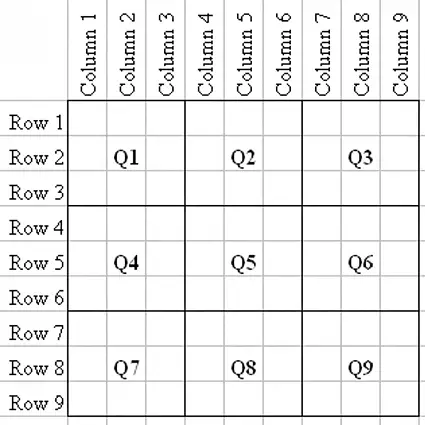
The basic Sudoku grid
The object of Sudoku is to place the numbers 1 through 9 in each Quadrant, Row, and Column without any number being repeated. For example, suppose there is a 3 in Quadrant 1, at Row 1 and Column 1. Then a 3 cannot be in any of the gray shaded areas shown in the following image.
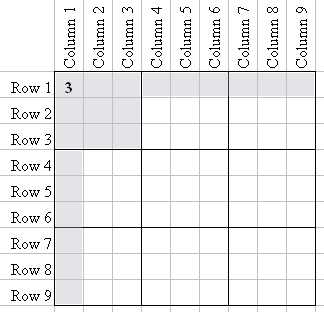
Each Sudoku puzzle has only one solution.
Now let's break down what I mean by 9 Quadrants, 9 Rows, and 9 Columns. For future reference I will refer to Quadrant 1 as "Q1", Quadrant 2 as "Q2", and so on. I will refer to Row 1 as "R1", Row 2 as "R2", and so on. I will refer to Column 1 as "C1", Column 2 as "C2", and so on.
If it is not clear to you yet, believe me, it will be once we start the puzzle.
Every Sudoku puzzle starts with some numbers already filled in. The easier the puzzle, the more numbers are provided; harder puzzles start with fewer numbers provided.
Using our sample puzzle, I will explain how to solve Easy puzzles and finish them completely, showing the basic techniques you will use on every Sudoku puzzle. After that we'll move on to the methods for solving Medium and Hard puzzles.
Two main techniques are used when solving an Easy Sudoku puzzle:
Check each number 1 through 9.
Check for one missing number in each Row, Column, and Quadrant.
Repeat the two techniques until the puzzle is solved. In our sample puzzle, as you will see below, we end up using each technique twice.
NOTE: If a Sudoku puzzle labeled as "Easy" cannot quite be solved using those two techniques alone, it might be necessary to make light use of Ghosting, RC Counting, Tagging, and Line Checking... methods explained in the next set of instructions, which covers how to solve Medium-difficulty Sudoku puzzles.
Sudoku Instruction: #1 - Check Each Number 1 Through 9
Here is the Easy Sudoku Sample puzzle that you printed earlier (print it out now if you haven't already done so). This is the starting point.
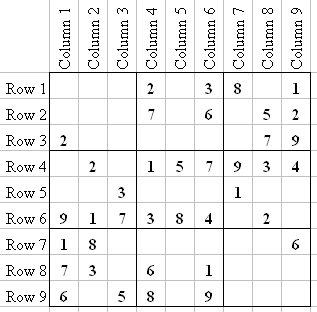
As I said earlier, Easy puzzles have a lot of numbers already filled in. What I suggest you do, as a beginner, is to start with number 1 and work your way through each number to number 9. Here, let me show you:
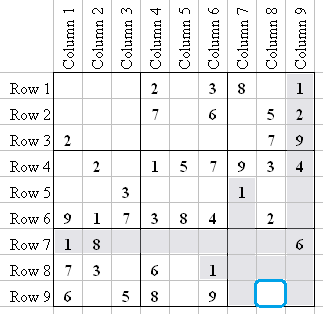
Notice that the number 1's in Row 7, Row 8, Column 7, and Column 9 are covering all the squares (gray shaded areas) in Quadrant 9, except one (circled in blue). Remember, per the rules of Sudoku, the numbers 1 through 9 can only appear once in each Row, Column, and Quadrant.
Each Quadrant has 9 squares. I will refer to them as position Q5-1, Q5-2, Q5-3, and so on. That is, start with the upper left square in the Quadrant as position 1, and then count left-to-right and top-to-bottom. So, for the 9th Quadrant in the above example, the number 1 can only go into the position Q9-8.
In the following image, I have entered a number 1 in Q9-8, in red, to show this. Now let's look at Q1.
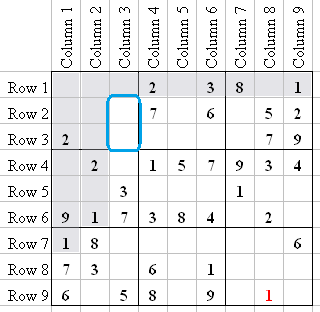
As you can see, there are two possible locations for the 1 in Q1 (that is, Q1-6 and Q1-9), so that doesn't help us. Q2 is the only Quadrant left for a 1 (because all the other Quadrants have a 1 in them already). Let's look at Q2.
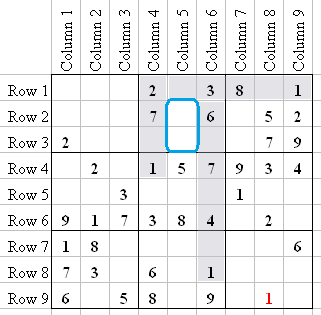
Just like Q1, there are two squares where the 1 can go in Q2 (that is, Q2-5 and Q2-7). So, for now, we don't know where the 1 goes in Q1 or Q2. So let's look at the number 2.
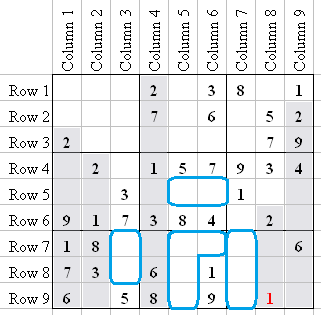
To speed this up, I highlighted in gray shading all the Columns where the 2 is already, to show where a 2 can possibly go in the other Quadrants. Notice that there are two open squares in Q5, two in Q7, four in Q8, and three in Q9. So there are no obvious single positions where a 2 can go. So let's move onto number 3.
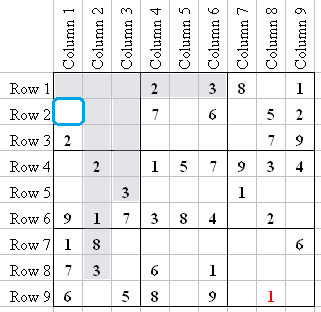
Notice in Q1, the 3 can only go into Q1-4. So I'll enter a 3 there.
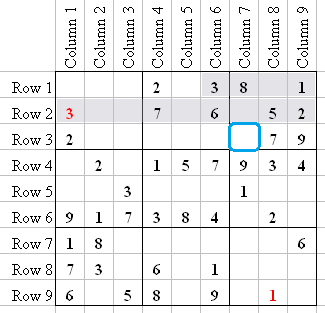
Entering a 3 in Q1-4 means Q3-7 has to be a 3.
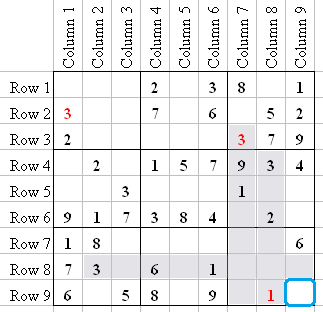
Entering a 3 in Q3-7 means a 3 has to go in Q9-9.
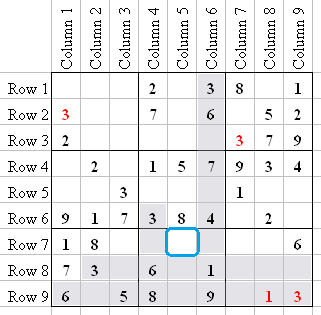
Entering a 3 in Q9-9 means the last 3 goes in Q8-2.
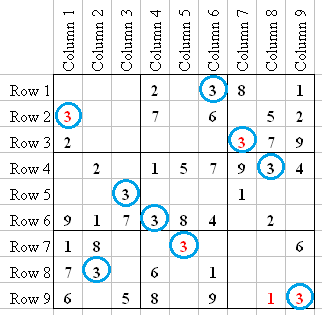
Just like that, every Quadrant, Row, and Column now has a 3. One number down, eight to go. So let's move on to 4.
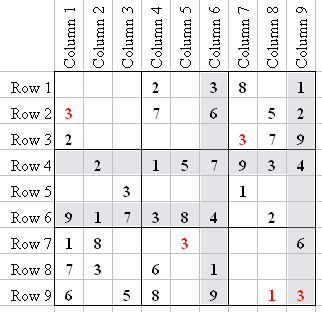
From this point on, I will no longer circle any locations in blue, so that you can practice seeing them for yourself.
As you can see in the image above, there are no clear single locations for a 4. In other words, in each Quadrant that is currently missing a 4, there is more than one location in that Quadrant where a 4 could possibly go. So let's try 5.
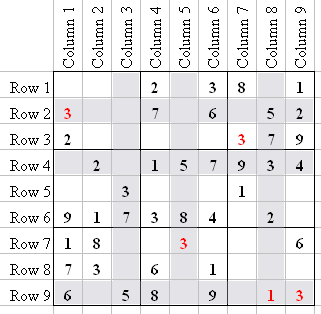
The number 5 also has no clear locations. Let's try 6.
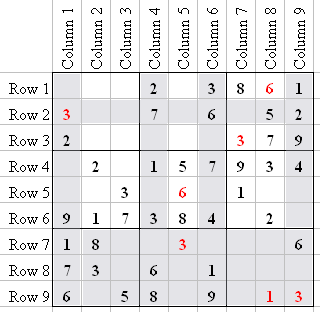
Q3-2 and Q5-5 are clear locations for a 6. Entering a 6 in Q3-2 makes Q6-7 a 6; entering a 6 at Q5-5 makes Q4-3 a 6; entering a 6 in Q4-3 and Q3-2 makes Q1-8 a 6. That finishes the 6. Two numbers down, seven to go.
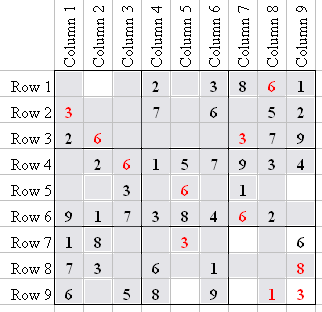
Now let's try 7. Q1-2, Q6-6, and Q8-8 can only be a 7. Entering a 7 in Q8-8 makes Q9-1 a 7. Three numbers down, six to go.
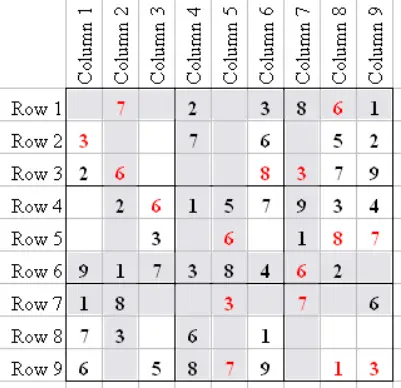
The 7s are now solved.
Now let's try 8. Q2-9 and Q6-5 are the only locations where an 8 can go. Entering an 8 in Q2-9 makes Q1-6 an 8, and entering an 8 in Q6-5 makes Q9-6 and Q4-1 an 8. We have finished with 8. Four numbers down, five to go. Let's try 9.
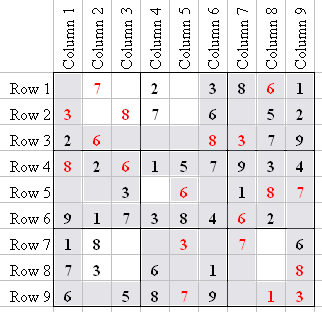
Q5-4 is the only place that has to be a 9.
Sudoku Instruction: #2 - Check for One Missing Number
Now that we have finished checking 1 through 9, we next want to check and see if any Quadrant, Row, or Column is only missing just one number.
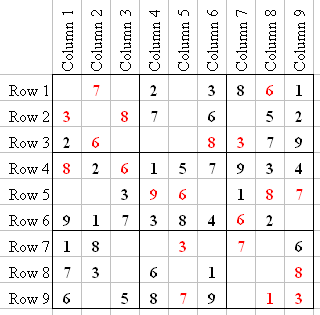
Q3 is only missing a 4. Q5 is only missing a 2, which means Column 6 is only missing a 5. C9 is only missing a 5.
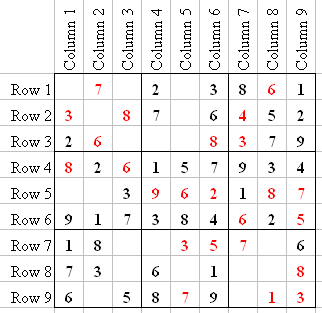
After checking every Quadrant, Row, or Column that is only missing one number, we end up with the above puzzle. The next step is to repeat the two Sudoku instructions steps that were shown above, looping again through the puzzle.
Repeat Sudoku Instruction #1: Check Numbers 1 Through 9
Now let's check the numbers 1 through 9 again to see if any of the numbers you just entered in Step 2 help tell you where another number goes.
I will not show the pictures again. Rather, I will just tell you what number goes where, and you can imagine the grey shaded lines in the Rows and Columns.
Let's try the number 1 again. Q1-9 is now a 1. Entering a 1 there make Q2-5 a 1. The number 1 is now done. Five numbers down, four to go. Let's check the 2.
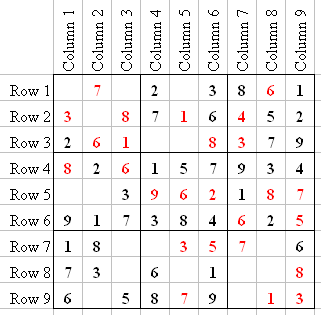
Q8-5 is a 2, making Q9-7 a 2 and Q7-3 a 2. The 2 is now done. Six numbers down. We only have three to go. The 3 was done earlier, so let's look at the 4 next.
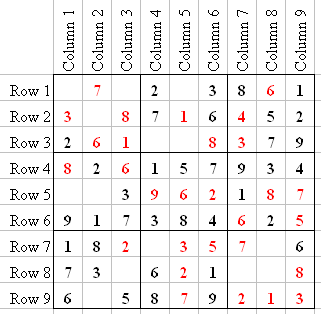
Q8 is only missing a 4, making Q9-5 a 4; entering a 4 there makes Q7-8 a 4; entering a 4 at Q7-8 makes Q4-4 a 4. After we enter a 4 in Q4-4, we can enter a 4 in Q1-3. The last 4 can then go in Q2-8. Seven numbers down, two to go.
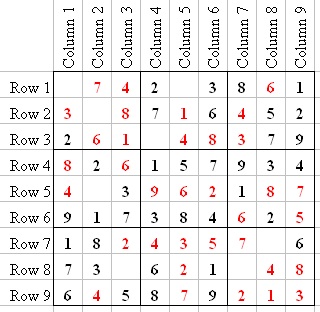
The puzzle is almost done.
Repeat Sudoku Instruction #2: Check for One Missing Number
Q7 is only missing a number 9, at Q7-6. Q4 is only missing a 5, at Q4-5. Now C2 is only missing a 9, at Q1-5. Q1 is now only missing a 5, at Q1-1. Row 1 is only missing a 9, at Q2-2. Q2 is now only missing a 5, at Q2-7. R8 is only missing a 5, at Q9-4, making the last number a 9 in Q9-2. The puzzle is done!
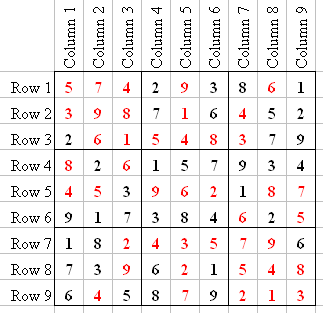
The Easy Puzzle Is Solved
The steps I showed you in the Sudoku instructions above are the same that will be used for every Sudoku puzzle.
I taught you to proceed from number 1 through number 9 to start the puzzle, but you don't have to do that every time. After a few more Easy puzzles, you will learn to spot which number goes where without going strictly in order from 1 through 9.
It is up to the person solving the puzzle. I like to take an overall look at the beginning to see if any number jumps out at me.
Thanks for reading; I hope this helps you to solve beginner Sudoku puzzles easily.
When you feel comfortable solving Easy puzzles, next read my Sudoku instructions on Medium Sudoku puzzles, where you will learn powerful Sudoku tricks like Ghosting, RC Counting, Tagging, and Line Checking. I hope it helps you with them as well.
~ Kevin RushPublished: 04/10/2020
Last Updated: 06/11/2020
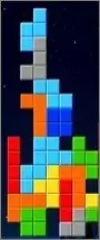
Newest / Popular
Multiplayer
Board Games
Card & Tile
Concentration
Math / Memory
Puzzles A-M
Puzzles N-Z
Time Mgmt
Word Games
- Retro Flash -
Also:
Bubble Pop
• Solitaire
• Tetris
Checkers
• Mahjong Tiles
•Typing
No sign-up or log-in needed. Just go to a game page and start playing! ![]()
Free Printable Puzzles:
Sudoku • Crosswords • Word Search




